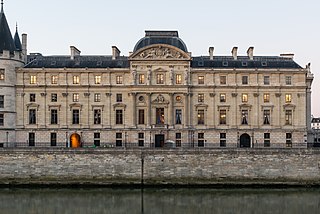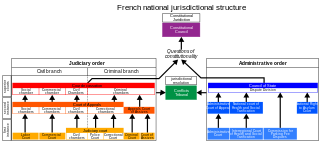Jurisprudence constante (French for "stable jurisprudence", or literally, "constant jurisprudence") is a legal doctrine according to which a long series of previous decisions applying a particular legal principle or rule is highly persuasive but not controlling in subsequent cases dealing with similar or identical issues of law. [1] This doctrine is recognized in most civil law jurisdictions as well as in certain mixed jurisdictions, e.g., Louisiana.
The rule of law applied in the jurisprudence constante directly compares with stare decisis . But the Louisiana Supreme Court notes the principal difference between the two legal doctrines: a single court decision can provide sufficient foundation for stare decisis; however, "a series of adjudicated cases, all in accord, form the basis for jurisprudence constante." [2] Moreover, the Louisiana Court of Appeal has explicitly noted that within Louisiana, jurisprudence constante is merely a secondary source of law, which cannot be authoritative and does not rise to the level of the source of law, which is legislation. [3] Judicial decisions are not intended to be an authoritative source of law, and, thus, the civilian tradition does not recognize the doctrine of stare decisis. Id.

In law, common law is the body of law created by judges and similar quasi-judicial tribunals by virtue of being stated in written opinions.
Precedent or stare decisis is a principle or rule established in a previous legal case relevant to a court or other tribunal when deciding subsequent cases with similar issues or facts. Common-law legal systems often view precedent as binding or persuasive, while civil law systems do not. Common-law systems aim for similar facts to yield similar and predictable outcomes, and observing precedent when making decisions is the mechanism to achieve that goal. Common-law precedent is a third kind of law, on equal footing with statutory law and subordinate legislation in UK parlance – or regulatory law. The principle by which judges are bound to precedents is known as stare decisis.
Case law, also used interchangeably with common law, is law that is based on precedents, that is the judicial decisions from previous cases, rather than law based on constitutions, statutes, or regulations. Case law uses the detailed facts of a legal case that have been resolved by courts or similar tribunals. These past decisions are called "case law", or precedent. Stare decisis—a Latin phrase meaning "let the decision stand"—is the principle by which judges are bound to such past decisions, drawing on established judicial authority to formulate their positions.

The Court of Cassation is the supreme court for civil and criminal cases in France. It is one of the country's four apex courts, along with the Council of State, the Constitutional Council and the Jurisdictional Disputes Tribunal.

In France, the Conseil d'État is a governmental body that acts both as legal adviser to the executive branch and as the supreme court for administrative justice, which is one of the two branches of the French judiciary system. Established in 1799 by Napoleon as a successor to the King's Council, it is located in the Palais-Royal in Paris and is primarily made up of top-level legal officers. The Vice President of the Council of State ranks as the ninth most important civil servant in France.
In legal writing, a dictum is a statement made by a court. It may or may not be binding as a precedent.
In American jurisprudence, the Restatements of the Law are a set of treatises on legal subjects that seek to inform judges and lawyers about general principles of common law. There are now four series of Restatements, all published by the American Law Institute, an organization of judges, legal academics, and practitioners founded in 1923.
The law of the case is a legal term of art that is applicable mainly in common law, or Anglo-American, jurisdictions that recognize the related doctrine of stare decisis. The phrase refers to instances where "rulings made by a trial court and not challenged on appeal become the law of the case." "Unless the trial court's rulings were clearly in error or there has been an important change in circumstances, the court's prior rulings must stand." Usually the situation occurs when either a case is on appeal for the second time—e.g. if the reviewing court remanded the matter to the trial court and the party appeals again or if the case was appealed in a higher appellate court—for example, from an appellate court to the highest court.
Ratio decidendi is a Latin phrase meaning "the reason" or "the rationale for the decision". The ratio decidendi is "the point in a case that determines the judgement" or "the principle that the case establishes".
In law, comity is "a principle or practice among political entities such as countries, states, or courts of different jurisdictions, whereby legislative, executive, and judicial acts are mutually recognized." It is an informal and non-mandatory courtesy to which a court of one jurisdiction affords to the court of another jurisdiction when determining questions where the law or interests of another country are involved. Comity is founded on the concept of sovereign equality among states and is expected to be reciprocal.
Judicial restraint is a judicial interpretation that recommends favoring the status quo in judicial activities and is the opposite of judicial activism. Aspects of judicial restraint include the principle of stare decisis ; a conservative approach to standing and a reluctance to grant certiorari; and a tendency to deliver narrowly tailored verdicts, avoiding "unnecessary resolution of broad questions."

French law has a dual jurisdictional system comprising private law, also known as judicial law, and public law.

The Supreme Court of Cassation is the highest court of appeal or court of last resort in Italy. It has its seat in the Palace of Justice, Rome.

The Federal Supplement is a case law reporter published by West Publishing in the United States that includes select opinions of the United States district courts since 1932, and is part of the National Reporter System. Although the Federal Supplement is an unofficial reporter and West is a private company that does not have a legal monopoly over the court opinions it publishes, it has so dominated the industry in the U.S. that legal professionals uniformly cite the Federal Supplement for included decisions. Approximately 40 new volumes are published per year.

Law in the state of Louisiana is based on a more diverse set of sources than the laws of the other 49 states of the United States. Private law—that is, substantive law between private sector parties, principally contracts and torts—has a civil law character, based on French and Spanish codes and ultimately Roman law, with some common law influences. Louisiana's criminal law largely rests on American common law. Louisiana's administrative law is generally similar to the administrative law of the federal government and other states. Louisiana's procedural law is generally in line with that of other U.S. states, which in turn is generally based on the U.S. Federal Rules of Civil Procedure.
Sources of law are the origins of laws, the binding rules that enable any state to govern its territory.

The law of the United States comprises many levels of codified and uncodified forms of law, of which the most important is the nation's Constitution, which prescribes the foundation of the federal government of the United States, as well as various civil liberties. The Constitution sets out the boundaries of federal law, which consists of Acts of Congress, treaties ratified by the Senate, regulations promulgated by the executive branch, and case law originating from the federal judiciary. The United States Code is the official compilation and codification of general and permanent federal statutory law.
Michigan v. Bay Mills Indian Community, 572 U.S. 782 (2014), was a United States Supreme Court case examining whether a federal court has jurisdiction over activity that violates the Indian Gaming Regulatory Act but takes place off Indian lands, and, if so, whether tribal sovereign immunity prevents a state from suing in federal court. In a 5–4 decision, the Court held that the State of Michigan's suit against Bay Mills is barred by tribal immunity.
Kimble v. Marvel Entertainment, LLC, 576 U.S. 446 (2015), is a significant decision of the United States Supreme Court for several reasons. One is that the Court turned back a considerable amount of academic criticism of both the patent misuse doctrine as developed by the Supreme Court and the particular legal principle at issue in the case. Another is that the Court firmly rejected efforts to assimilate the patent misuse doctrine to antitrust law and explained in some detail the different policies at work in the two bodies of law. Finally, the majority and dissenting opinions informatively articulate two opposing views of the proper role of the doctrine of stare decisis in US law.
Louisiana Power & Light Co. v. City of Thibodaux, 360 U.S. 25 (1959), was a case in which the Supreme Court created a new doctrine of abstention.